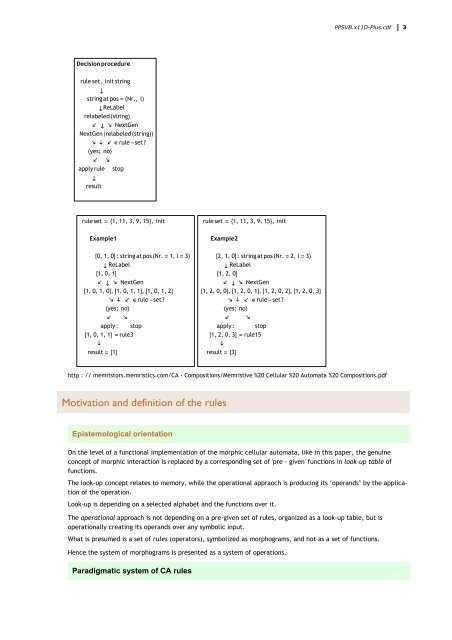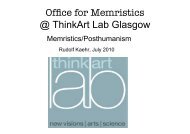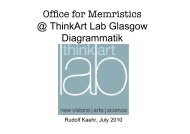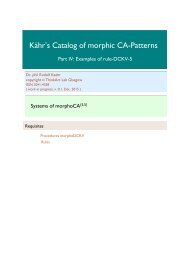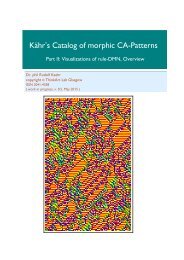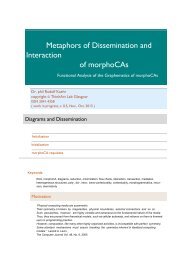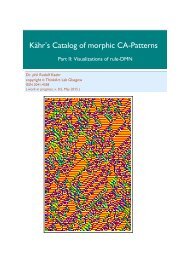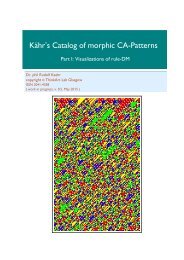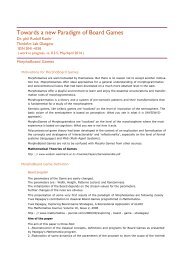A Kind of a New Music Box
A Tool Box for sonic and visual deep-structural adventures by comparing classical, indicational and morphic CA. Motto: If words are not going to be listened to and notions are not going to be understood, there is still a chance of showing some pictures and making some noise, with an offer to motivate to enjoy or to conceive their differences and also to try to overcome the attitude of blind and deaf denial of conceptual thinking. Interactivity for Sound and Visualizations needs the formats Wolfram CDF or HTML. http://www.thinkartlab.com/Memristics/PPSVB-Plus/PPSVB.x11D-Plus.html , soundtracks at: https://soundcloud.com/morphicalgorithms/tracks, more information at: http://the-chinese-challenge.blogspot.co.uk
A Tool Box for sonic and visual deep-structural adventures
by comparing classical, indicational and morphic CA.
Motto:
If words are not going to be listened to and notions are not going to be understood, there is still a chance of showing some pictures and making some noise, with an offer to motivate to enjoy or to conceive their differences and also to try to overcome the attitude of blind and deaf denial of conceptual thinking. Interactivity for Sound and Visualizations needs the formats Wolfram CDF or HTML. http://www.thinkartlab.com/Memristics/PPSVB-Plus/PPSVB.x11D-Plus.html , soundtracks at:
https://soundcloud.com/morphicalgorithms/tracks, more information at: http://the-chinese-challenge.blogspot.co.uk
Create successful ePaper yourself
Turn your PDF publications into a flip-book with our unique Google optimized e-Paper software.
PPSVB.x11D-Plus.cdf 3<br />
Decision procedure<br />
rule set, init string<br />
string at pos = (Nr., l)<br />
ReLabel<br />
relabeled (string)<br />
↙ ↘ NextGen<br />
NextGen (relabeled (string))<br />
↘ ↓ ↙ ∈ rule - set ?<br />
〈yes; no〉<br />
↙ ↘<br />
apply rule stop<br />
result<br />
rule set = {1, 11, 3, 9, 15}, init<br />
Example1<br />
[0, 1, 0] : string at pos (Nr. = 1, l = 3)<br />
ReLabel<br />
[1, 0, 1]<br />
↙ ↘ NextGen<br />
[1, 0, 1, 0], [1, 0, 1, 1], [1, 0, 1, 2]<br />
↘ ↓ ↙ ∈ rule - set ?<br />
〈yes; no〉<br />
↙ ↘<br />
apply : stop<br />
[1, 0, 1, 1] = rule3<br />
↓<br />
result = [1]<br />
rule set = {1, 11, 3, 9, 15}, init<br />
Example2<br />
[2, 1, 0] : string at pos (Nr. = 2, l = 3)<br />
ReLabel<br />
[1, 2, 0]<br />
↙ ↘ NextGen<br />
[1, 2, 0, 0], [1, 2, 0, 1], [1, 2, 0, 2], [1, 2, 0, 3]<br />
↘ ↓ ↙ ∈ rule - set ?<br />
〈yes; no〉<br />
↙ ↘<br />
apply : stop<br />
[1, 2, 0, 3] = rule15<br />
↓<br />
result = [3]<br />
http : // memristors.memristics.com/CA - Compositions/Memristive %20 Cellular %20 Automata %20 Compositions.pdf<br />
Motivation and definition <strong>of</strong> the rules<br />
Epistemological orientation<br />
On the level <strong>of</strong> a functional implementation <strong>of</strong> the morphic cellular automata, like in this paper, the genuine<br />
concept <strong>of</strong> morphic interaction is replaced by a corresponding set <strong>of</strong> 'pre - given' functions in look-up table <strong>of</strong><br />
functions.<br />
The look-up concept relates to memory, while the operational appraoch is producing its ‘operands’ by the application<br />
<strong>of</strong> the operation.<br />
Look-up is depending on a selected alphabet and the functions over it.<br />
The operational approach is not depending on a pre-given set <strong>of</strong> rules, organized as a look-up table, but is<br />
operationally creating its operands over any symbolic input.<br />
What is presumed is a set <strong>of</strong> rules (operators), symbolized as morphograms, and not as a set <strong>of</strong> functions.<br />
Hence the system <strong>of</strong> morphograms is presented as a system <strong>of</strong> operations.<br />
Paradigmatic system <strong>of</strong> CA rules


